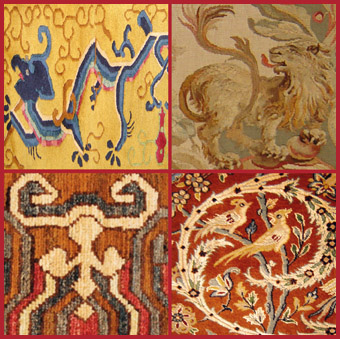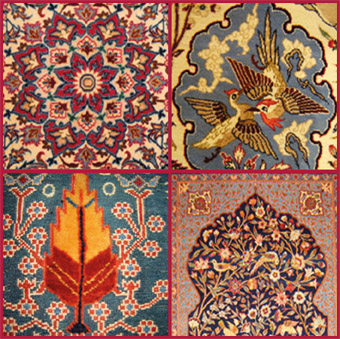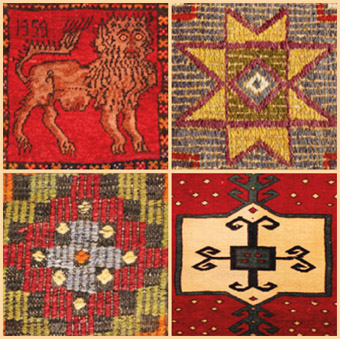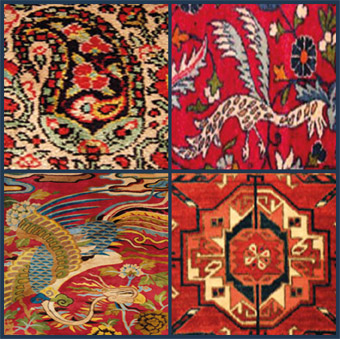



RUG MOTIFS: THE WOVEN WORD
The pattern and design of Oriental Rug weavings contain a wealth of iconic and symbolistic motifs, allowing us a glimpse into an otherwise hidden world, rich in artistic expression. Rug motifs reveal an ancient language of metaphorical themes and allegorical elements drawn from the weaver’s world that have been adapted over the generations, where the ‘woven word’ provided a more enduring, pictorial form of recording ancestral traditions and family lineage, where reading and writing skills and pen and paper were not used or in scarce supply.
Originally totemic and talismanic in nature, rug motifs were deeply rooted in the natural elements and spiritual beliefs that afforded protection, prosperity, fertility and good fortune and stylised according to the type of weave and the weaver’s cultural aesthetic. Embellishments, with amulets such as cowrie shells, beads, metals and precious stones, personalised and further decorated woven pieces.
Here, Anas and Sandre have selected a range of characteristic motifs sourced from their rug collections at The Oriental Rug Gallery Ltd, listed below, to help you as a guide. Often stylised and variously embedded within the main field or borders, search to discover if these ancient symbols have been woven into your rug:
Boteh: the precursor to ‘paisley’ design in the West, this ancient fertility symbol details a seed shape often enclosing a plant or flower head within, symbolising life and renewal, where the whole exists within the part eg ‘from the acorn comes forth the oak’. (see montage: 3)
Tree of Life: an ancient symbol of immortality, longevity and resurrection, where the trunk, branches and flowers or fruit signify the human journey of life and the proliferation of ancestry and is the origin of the ‘Family Tree’ diagram used today. (see montage: 1)
Star: can be five- six- eight- and sixteen-pointed, symbolising the sacred unification of the six universal directions and natural elements, the wheel of life, fertility and our human interconnection with the world in which we live. (see montage: 2)
Phoenix or Peacock: an ancient symbol that is interchangeable and can be transposed with the sun-bird totem, to represent wisdom, rebirth and regal power. (see montage: 3)
Eye of protection: a popular talismanic symbol to ward off evil, death and misfortune, where the eye is also known as the ‘window to the soul’. (see montage: 2)
Lion: courage, regal, powerful (see montages: 2&4)
Dragon: life-force, strength, courage, guardians of treasure. (see montages: 3&4)
Mandala or Central Medallion: representing wholeness, continuity, unity, harmony and the wheel of life.(see montage: 1)
Ornate Archway or Mihrab: entrance to the World of Spirit or the Gardens of Paradise. (see montage: 1)
Gül & Memline Gül: octagonal and hexagonal-shaped geometric medallions meaning ‘flower’ or ‘rose’, where hooked guls were detailed in paintings by Flemish Master Hans Memling in 15th Century. Used as repeat motifs in Turkmen, Caucasian and Anatolian pieces, where various ornamentations depicted within the motif are specifically attributed monikas to the village or tribe where the weaving was crafted. (see montage: 3)
Ram horns: power, heroism, masculinity and fertility. (see montages: 2&4)
Two birds: a pair either facing inwards or outwards symbolise love, harmony, joy and marriage (see montages: 1&4)


